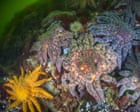
In a series of recent developments, scientists and technologists around the world are making strides in combating environmental challenges, advancing renewable energy, and revolutionizing communication technologies. These efforts underscore the dynamic interplay between scientific inquiry and technological innovation, offering hope for sustainable solutions to pressing global issues.
In an optimistic breakthrough for marine conservation, researchers have successfully identified the bacterium responsible for the devastating sea star wasting disease, offering a potential pathway to address ecological imbalance. The bacterium, a strain of Vibrio pectenicida, has been linked to the dramatic decline of the sunflower sea star population, which has seen a staggering 90% reduction over the past decade. This ecological crisis has taken a toll on these oceanic giants, now listed as critically endangered by the International Union for Conservation of Nature.
The sunflower sea star plays a crucial role in marine ecosystems, and understanding the bacterium’s role provides a compelling opportunity to develop strategies for protecting remaining populations. The identification of this microbial culprit marks a pivotal step forward, as conservationists and marine biologists work towards restoring balance to coastal habitats severely impacted by this epidemic.
Simultaneously, on the energy frontier, innovative research in Australia is transforming two notorious invasive weed species into a promising renewable energy source. Scientists at the University of Queensland have discovered that Brazilian nightshade and climbing asparagus can be converted into biomass pellets, a development that could significantly contribute to Australia’s energy transition. By repurposing these aggressive vines into biofuel, researchers are highlighting an inventive synergy between ecological management and sustainable energy production, turning environmental challenges into opportunities for cleaner energy.
As weed proliferation poses ongoing threats to native biodiversity and agriculture, this discovery signifies a positive step toward mitigating environmental impact while fostering renewable energy solutions. The capacity to harness invasive plant material for energy underscores the importance of creative approaches to ecological challenges, promising a greener future.
In the realm of technology, advancements continue to enhance interconnectivity and user accessibility. OpenAI has announced the launch of two open-weight large language models, positioned as rivals to Meta’s offerings. These customizable and freely available models emphasize OpenAI’s commitment to fostering broad accessibility in artificial intelligence, providing users with versatile tools tailored to diverse applications.
This venture into open-source AI models signifies a broader trend towards democratized access to cutting-edge technology, enabling a wider spectrum of users to harness AI capabilities for personal and professional growth. The availability of such models opens doors to innovation across industries, enhancing productivity and creativity in various fields.
Meanwhile, WhatsApp has introduced a novel feature designed to bridge communication gaps, allowing users to connect with individuals who do not have the application installed. Known as “guest chats,” this new functionality integrates seamlessly within the app’s ecosystem, fostering greater inclusivity in communication options. Such advancements reflect ongoing efforts to make digital communication more accessible and inclusive, ensuring that technology continues to adapt to the diverse needs of global users.
Collectively, these scientific and technological developments highlight the powerful potential of innovation to address global challenges. By advancing our understanding of ecological threats, paving the way for renewable energy use, and enhancing digital interconnectivity, these initiatives underscore a shared commitment to a sustainable and equitable future. As we navigate an increasingly complex world, these innovations provide a beacon of hope and resilience for humanity and the environment alike.
Source: {link}
